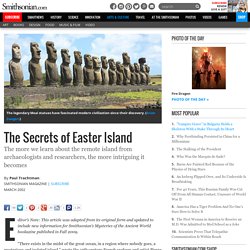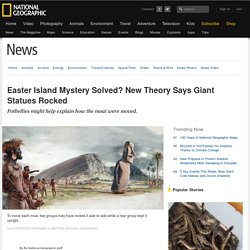

The Secrets of Easter Island. Editor’s Note: This article was adapted from its original form and updated to include new information for Smithsonian’s Mysteries of the Ancient World bookazine published in Fall 2009.

“There exists in the midst of the great ocean, in a region where nobody goes, a mysterious and isolated island,” wrote the 19th-century French seafarer and artist Pierre Loti. “The island is planted with monstrous great statues, the work of I don’t know what race, today degenerate or vanished; its great remains an enigma.” Named Easter Island by the Dutch explorer Jacob Roggeveen, who first spied it on Easter Day 1722, this tiny spit of volcanic rock in the vast South Seas is, even today, the most remote inhabited place on earth.
Its nearly 1,000 statues, some almost 30 feet tall and weighing as much as 80 tons, are still an enigma, but the statue builders are far from vanished. In fact, their descendants are making art and renewing their cultural traditions in an island renaissance. History, Travel, Arts, Science, People, Places. Easter Island. “The statues walked,” Easter Islanders say.

Archaeologists are still trying to figure out how—and whether their story is a cautionary tale of environmental disaster or a celebration of human ingenuity. By Hannah Bloch Video Animation by Hans Weise, Spencer Millsap, Fernando G. Baptista, and Fanna Gebreyesus On a winter night last June, José Antonio Tuki, a 30-year-old artist on Easter Island, did one of the things he loves best: He left his one-room home on the southwest coast and hiked north across the island to Anakena beach. Sleepless roosters crowed; stray dogs barked. Easter Island covers just 63 square miles.
But lately the moai have been drawn into a larger debate, one that opposes two distinct visions of Easter Island’s past—and of humanity in general. When the Polynesian settlers arrived at Rapa Nui, they had been at sea for weeks in open canoes. Chile annexed Easter Island in 1888, but until 1953 it allowed a Scottish company to manage the island as a giant sheep ranch. Easter Island - Video: Testing a Walking Theory. Easter Island Mystery Solved? New Theory Says Giant Statues Rocked.
For centuries, scientists have tried to solve the mystery of how the colossal stone statues of Easter Island moved.

Now there's a new theory—and it rocks. The multiton behemoths traveled up to 11 miles (18 kilometers) from the quarry where most of them were carved, without the benefit of wheels, cranes, or even large animals. Scientists have tested many ideas in the past, figuring that the islanders must have used a combination of log rollers, ropes, and wooden sledges.
Now a pair of archaeologists have come up with a new theory: Perhaps the statues, known as moai, were "engineered to move" upright in a rocking motion, using only manpower and rope. Watch video: Easter Island statues rocking forward Terry Hunt of the University of Hawaii and Carl Lipo of California State University Long Beach have worked closely with archaeologist Sergio Rapu, who's part of the South Pacific island's population of indigenous Rapanui, to develop their idea. Pioneers of Easter Island. By Liesl Clark Posted 02.15.00 NOVA Ever since the Dutchman Jacob Roggeveen, the first European known to have reached Easter Island, arrived in 1722, scholars have debated the origins of the isolated population he found there.

Did they sail from the east, from South American soil, or from Central Polynesia to the north and west? It is daunting to imagine a voyage to Easter Island from any direction, which would have taken a minimum of two weeks, covering several thousand miles of seemingly endless ocean. It is clear, however, that the original inhabitants must have come from a seafaring culture, adept at building long-voyaging vessels and navigating the open seas. Where did the original Easter Islanders come from? Arrival Linguists estimate Easter Island's first inhabitants arrived around A.D. 400, and most agree that they came from East Polynesia. On Rapa Nui, the more modern, and local, name for Easter Island, large palm forests flourished.
Enigmas Which wall is Incan and which Rapanui?